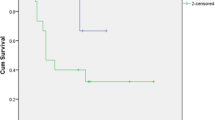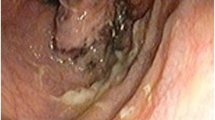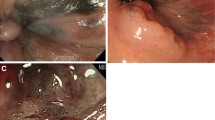Abstract
Clinicopathologic features and surgical treatment of 15 patients with primary anorectal malignant melanoma were studied retrospectively. There was a female preponderance (2:1). The median age was 66 years. Common initial symptoms were rectal bleeding (87%) and/or anal pain (33%); 25% of the melanomas were amelanotic. The maximum tumor size ranged between 0.8 and 8.4 cm (median 3.0 cm). Of the tumors evaluated histologically (n=12), tumor thickness ranged from 0.9 to 11.3 mm (median 6.1 mm). All melanomas invaded at least into the subepithelial tissue (n=8) and/or the submucosa of the distal rectum (n=4), with extension into the internal anal sphincter (n=5) and lamina propria (n=3). Endoluminal ultrasound accurately demonstrated depth of invasion in 3 of 3 patients. Three (20%) patients with distant metastases at initial presentation had a mean survival of 8 mo; one of these primary melanomas measured 0.8 cm. Of 12 patients undergoing “curative” treatments — 4 by abdominoperineal resection (APR) and 8 by local excision (LE), the incidence of loco-regional recurrence was similar (2/4 and 5/8). All these 7 patients with loco-regional recurrence developed distant metastases within 3 months. The mean survival was similar between APR and LE in the total group (25 mo vs 20 mo), in the decreased (27 mo vs 24 mo) and in those treated with a curative intent (29 mo vs 22 mo). There was no long-term survivor but four patients remained tumor-free up to 19 mo after APR (n=1) or LE (n=3). Thus anorectal melanoma has a poor prognosis and, when technically feasible, LE appears to have similar results as APR.
Résumé
Les aspects clinico-pathologiques et le traitement chirurgical de 15 malades présentant un mélanome malin primitif ano-rectal ont été étudiés rétrospectivement. Il y avait une prépondérance féminine (2:1). L'âge moyen était de 66 ans. Le premier symptome commun était une rectorragie (87%) et ou une douleur anale (33%); 25% de ces mélanomes étaient achromiques. Le diamétre maximal de la tumeur était compris entre 0,8 et 8,4 cm (médiane 3,0 cm). Sur les tumeurs examinées histologiquement (n=12), l'épaisseur de la tumeru était comprise entre 0,9 et 11 mm (moyenne 6,1 mm). Tous ces mélanomes envahissaient au moins le tissu sub-épithélial (n=8) et/ou la sous muqueuse du rectum distal (n=4), avec une extension dans le sphincter anal interne (n=5) ou la lamina propria (n=3). L'échographie endorectale a montré de façon précise la profondeur de l'invasion chez 3 patients sur 3. Trois patients (20%), avec des métastases à distance lors de l'examen initial, ont eu une moyenne de survie de 8 mois. L'un de ces mélanomes primaires mesurait 0,8 cm. Sur les 12 patients ayant eu un traitement “curatif”-4 amputations abdomino-périnéales (AAP) et 8 excisions locales (LE)-l'incidence de récidive loco-régionale fut similaire (2/4 et 5/8). Tous les 7 patients avec une récidive loco-régionale ont développé des métastases à distance dans les 3 mois. La moyenne de survie était similaire après AAP ou LE dans le groupe total (25 mois versus 20 mois), chez les malades décédés (27 mois versus 24 mois), et chez ceux traités avec une intention curative (29 mois versus 22 mois). Il n'y a pas eu de survie à long terme mais 4 patients demeurent indemmes de récidive jusqu'à 19 mois après AAP (n=1) ou LE (n=3). Ainsi le mélanome ano-rectal a un pronostic défavorable et, lorsque cela est techniquement possible, l'excision locale semble avoir des résultats similaires à l'amputation abdomino-périnéales.
Similar content being viewed by others
References
Pack GT, Oropeza R (1967) A comparative study of melanoma and epidermoid carcinoma of the anal canal: a review of 20 melanomas and 29 epidermoid carcinomas (1930 to 1965). Dis Colon Rectum 10:161–167
Morson BC, Volkerstadt H (1963) Malignant melanoma of the anal canal. J Clin Path 16:126–132
Husa A, Hockerstedt K (1974) Anorectal malignant melanoma: a report of 14 cases. Acta Chir Scand 140:68–72
Pack GT, Lenson N, Gerber DM (1952) Regional distribution of moles and melanomas. AMA Arch Surg 65:862–870
Moore WD (1857) Recurrent melanoma of the anus after previous removal from verge of anus. Lancet 1:290
Braastad FW, Dockerty MB, Dixon CF (1949) Melanoepithelioma of the anus and rectum. Surgery 25:82–85
Mason JK, Helwig EB (1966) Anorectal melanoma. Cancer 19:39–50
Wanebo HJ, Woodruff JM, Farr GH, Quan SH (1981) Anorectal melanoma. Cancer 47:1891–1900
Quan SH, Deddish MR (1966) Noncutaneous melanoma. CA 16:111–114
Angeras U, Jonsson N, Jonsson P (1983) Primary anorectal malignant melanoma. J Surg Oncol 22:261–264
Balch CM, Soong SJ, Murad TM, Ingalls AL, Maddox WA (1979). A multifactorial analysis of melanoma. II: Prognostic factors in patients with Stage I (localized) melanoma. Surgery 86:343–350
Quan SHQ, White JE, Deddish MR (1959) Malignant melanoma of the anorectum. Dis Colon Rectum 2:275–283
Baskies AM, Sugarbaker EV, Chretien PB, Deckers PJ (1983) Anorectal melanoma: the role of posterior pelvic exenteration. Dis Colon Rectum 25:772–777
Chiu YS, Unni KK, Beart RW (1980) Malignant melanoma of the anorectum. Dis Colon Rectum 23:122–124
Ward MWN, Romano G, Nicholls RJ (1986) The surgical treatment of anorectal malignant melanoma. Br J Surg 73:68–69
Tjandra JJ, Milsom JW, Stolfi VM, Lavery IC, Oakley J, Church J, Fazio W (1992) Endoluminal ultrasound defines anatomy of the anal canal and pelvic floor. Dis Colon Rectum 35:465–470
Church JM, Fazio VW (1986) Abdominoperineal resection of the rectum. In: Madden JL (ed) Problems in general surgery, vol. 3, Lippincott Co, Philadelphia, pp 221–234
Fazio VW (1991) Curative local therapy of rectal cancer. Int J Colorect Dis 6:66–73
Cooper PH, Mills SE, Allen MS (1982) Malignant melanoma of the anus: Report of 12 patients and analysis of 255 additional cases. Dis Colon Rectum 25:693–703
Kantarovsky A, Kaufman Z, Zager M, Lew S, Dinbar A (1988) Anorectal malignant melanoma. J Surg Oncol 38:77–79
Clark WH, Elder DE, Guerry D et al. (1989) Model predicting survival in stage I melanoma based on tumor progression. J Natl Cancer Inst 81:1893–1904
Kirkham N, Cotton DWK (1984) Measuring melanomas: the Vernier method. J Clin Pathol 37:229–230
Lewin KJ, Riddell RH, Weinstein WM (1992) The anal canal. In: Lewin KJ, Riddell RH, Weinstein WM. Gastrointestinal pathology and its clinical implications, vol. 2. Igaku-Shoin, New York, pp 1318–1359
Werdin C, Limas C, Knodell RG (1988) Primary malignant melanoma of the rectum: evidence for origination from the rectal mucosal melanocytes. Cancer 61:1364–1370
Freedman LS (1984) Malignant melanoma of the anorectal region: Two cases of prolonged survival. Br J Surg 71:164–165
Goldman S, Glimelius B, Påhlman L (1990) Anorectal malignant melanoma in Sweden. Report of 49 patients. Dis Colon Rectum 33:874–877
Mills SE, Cooper PH (1983) Malignant melanoma of the digestive tract. In: Sommers SC, Rosen PP (eds) Pathology Annual Part 2. Prentice Hall, Norwalk, pp 1–26
Chung AF, Cassey MJ, Flannery JT, Woodruff JM, Lewis JL (1980) Malignant melanoma of the vagina: a report of 19 cases. Obstet Gynecol 55:720–727
Stearns MW, Urmacher R, Sternberg SS (1980) Cancer of the anal canal. In: Hickey RC (ed) Current problems in cancer, vol IV, Year Book Medical, Chicago, 12–33
Wong J, Cagle L, Storm K, Morton D (1987) Natural history of surgically treated mucosal melanoma. Am J Surg 154:54–57
McKinnon JG, Kokal WA, Neifeld JP, Kay S (1989) Natural history and treatment of mucosal melanoma. J Surgy Oncol 41:222–225
Milsom JW, Lavery IC, Stolfi VM, Oakley J, Church J, Fazio VW (1992) The expanding utility of endoluminal ultrasonography in the management of rectal cancer. Surgery 2:832–841
Pyper PC, Parks TG (1984) Melanoma of the anal canal. Br J Surg 71:671–672
Garnick M, Lokich JJ (1978) Primary malignant melanoma of the rectum: rationale for conservative surgical management. J Surg Oncol 10:529–531
Abbas JS, Karakousis CP, Holyoke ED (1980) Anorectal melanoma: clinical features, recurrence and patient survival. Int Surg 65:423–426
Bolivar JC, Harris JW, Branch W, Sherman RT (1982) Melanoma of the anorectal region. Surg Gynceol Obstet 154:337–341
Author information
Authors and Affiliations
Rights and permissions
About this article
Cite this article
Antoniuk, P.M., Tjandra, J.J., Webb, B.W. et al. Anorectal malignant melanoma has a poor prognosis. Int J Colorect Dis 8, 81–86 (1993). https://doi.org/10.1007/BF00299333
Received:
Accepted:
Issue Date:
DOI: https://doi.org/10.1007/BF00299333




